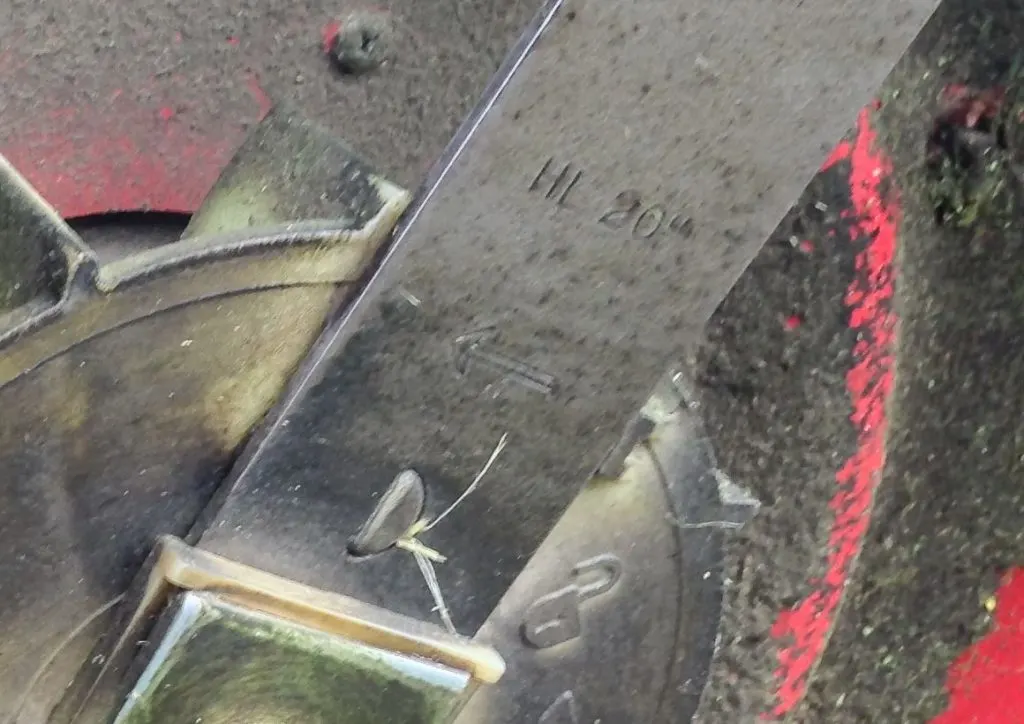Understanding the specifics of lawn mower blades can be tricky. You’ve come to the right place for a definitive answer. With our extensive knowledge of the subject, we can confidently guide you through the intricacies of lawn mower blades.
Lawn mower blades are not universal. There are different types – low lift, high lift, deck, mulching, and 3-in-1 blades – each with a specific design and lift for mowing functions and lawn conditions. To get the right blade, check the manual, model, blade markings, or measure dimensions.

Immerse yourself in our detailed analysis of mower blades. Understand why they are not one-size-fits-all and how their design influences mowing functions. Learn how to determine the right blade for your mower. Let’s embark on this journey to a greener lawn!
Contents
- 1 Identify your Lawn Mower Blade
- 2 The Main Types of Lawnmower Blades and Which Is Best For Your Mower
- 3 What are the best Lawn Mower Blades?
- 4 Remarks
Identify your Lawn Mower Blade
There are several ways to identify your lawn mower blade:
- Check the manual
- Use the model and make
- Check the current blade number
- Measure the blade dimensions
● Check the User manual
Using the manual is the easiest way to identify your lawn mower blade. There, you will find the details of a replacement blade.
● Use the Model and make
Use the mower model and search on Amazon for suitable replacement blades.
● Check the Current blade number
Check your mower blade for a number that is stamped into the metal. This number is blade type-specific, and often, you can use it to google a replacement part

● Measure the blade dimensions
If other methods to find a replacement blade do not work, you can measure the blade dimensions and use those to find a suitable replacement. You’ll be required to check for the following:
- The length
- The width and
- The thickness
As stated earlier, these dimensions always vary from manufacturer to manufacturer. This is why measurement accuracy is vital in identifying your correct replacement blade. When you have measured the dimensions, you can use Google to find a suitable replacement.
– Blade Length:
Mower blades come in different sizes ranging from 6” to over 32” in length. To measure, start at one end and measure diagonally to the opposite corner.
– Blade Width:
They range from 1½” to 4¼” and are measured straight across, from one outer edge to the opposing outer edge. You will find it in the center, right near the center hole of the blade.
– Blade Thickness or Depth:
Varying from 1/10” to nearly 1/3”, this measurement runs straight through the blade from one outer edge to the other. Look for the broadest existing thickness/depth and measure at that location.
The Main Types of Lawnmower Blades and Which Is Best For Your Mower
One factor that can be helpful to you as a lawn owner or landscaper is identifying the different types of blades available- this would help you achieve the desired results in the long run.
Identifying the different blade types will help you determine the kind of lawn mower with the right blade that works best for your lawn, especially in highly sandy soil conditions. On the other hand, selecting the wrong blade will affect the final appearance of your yard and can even cause damage to your mower.
You’ll find several designs and types of lawn mower blades on the market that provide a variety of lift and mulching options. Features such as size, length, thickness, design, and material vary from manufacturer to manufacturer.
In my 20 years of experience, I’ve found that the compatibility of a lawn mower blade is determined by factors such as length, width, center hole type, and thickness. It’s also crucial to consider the mower’s horsepower and the manufacturer’s specifications.
• Understanding the Functions of a Lawn Mower Blade
Generally, a lawn mower blade should be able to perform three main functions, which include mulching, discharging, and bagging. Many blades can carry out all three functions; others can only perform one.
Typically, a lawn mower will only use a blade that matches the configuration of its holes and measurements, but several mowers still have options for compatible blade types.
If your mower blade is non-cutting or exaggerated, it’s time to replace your lawn mower blade. Remember, when cutting grass, using the correct blade is essential to prevent damage to your lawn and mower. So, don’t hesitate to replace your lawn mower blade if necessary.
Below are the main types of blades available:
● Low Lift Blades
Low-lift mower blades are often recommended for lawns with sandy soil and dry, shorter grasses. These blade types are specially designed for side discharge mowing.
Their features include a slightly curved blade edge that controls the flow of air and a low suction power with a less drastic swoop- this ensures that the grass remains low in the area where it is more available to be ejected at the side of the mower. This will help keep dust and debris to a minimum.
– Benefits of low lift blades:
- They have curved ends that keep air pressure to a minimum, allowing the cut grasses to exit the mower while maintaining a minimum dust and debris level.
- Low lift blades do not cause stress on the mower engines.
● High Lift Blades
Unlike their low-lift counterparts, high-lift blades are specifically designed for lawns with wet and tall grass, requiring a high horsepower engine. The blades have deeper curves on each end, providing a high suction level to send the grass clippings into a bagger.
Having a vertical swoop shape, the high lift air beneath the mower provides a high suction. This makes bagging more efficient and reduces the chances of clogging.
– Benefits of high lift blades:
- High lift blades provide high airflow and suction that prevents clogging, especially when dealing with wet or tall grass.
- They cut grass neatly before bagging and discharging them.
● Deck Blades
This is also called a standard blade, the most commonly used blade for lawnmowers with horizontal rotation. They have slightly curved edges, generating a continuous airflow as they rotate, providing a suction and cut function.
– Benefits of deck blades:
- These blades are straight and have an aerodynamic design, providing a mighty lift that efficiently discharges the grass clippings from the deck. They are also durable.
- Deck blades can run for extended periods so that you can achieve more results quickly. They are great options for lawns that are not mowed regularly.
- They are usually the perfect option when mulching when grass clippings are not feasible.
- Deck blades are easy to install and match many lawn mower models.
Using an incompatible blade can lead to poor cutting performance, increased wear and tear on the mower, and potential safety hazards. It’s always best to use the right blade for your mower.
● Mulching Blade
A mulching blade is also known as an all-purpose blade. The blade is designed to have a curved surface, allowing it to carry out the three primary functions: mulching, discharging, and bagging.
The blade starts by cutting the grass; the grass clippings are then drawn into the deck, which is further chopped into smaller pieces. Finally, the innermost curve of the blade produces pressurized air, which discharges the small clippings.
This design allows the grass to be chopped into smaller pieces before they are finally bagged or inserted into the soil for mulching.
– Benefits of mulching blades:
- Mulching blades are versatile because they can perform all three functions instead of one.
- The curved blades keep the grass clippings in the deck, enabling them to reduce the clippings into smaller pieces. Also, the extended curved surface allows you to achieve more cuts in less time.
- When mulched grasses are released into the soil, they decompose faster, releasing valuable nutrients into the soil to help improve the growth of the grasses. In other words, mulching blades are environmentally friendly.
● 3-in-1 or Gator Blade
As the name suggests, 3-in-1 blades combine the low, medium, and high lift techniques into a single blade. These features include a serrated edge at both ends of the blade, allowing an all-around cutting. These blades are suitable for mowing in sandy terrains while providing the quality mulch you want.
– Benefits of gator blades:
- Unlike other blades that push grass down, gator blades push the grass up instead. This is simply due to the raised teeth on the blades. These teeth are also responsible for directing the grass towards the cutting edge, ensuring a cleaner and neater cut with finer grass clippings.
- Gator blades are made with a progressive geometry on the edges to increase the airflow, facilitating the side discharge and quality bagging. Also, the edges remain sharp for a long time, minimizing the need to sharpen and replace your blade constantly.
What are the best Lawn Mower Blades?
That being said, there is no such thing as the best or perfect lawn mower blades for your mower. All these blades are specifically made to have their unique properties and benefits.
So when shopping for a mower blade, you should consider the one best suited for your lawnmower and your lawn rather than the perfect one; this will help you achieve the best results. As fall approaches, it’s essential to consider the type of lawn mower blades you’re using.
Low-lift lawn mower blades are ideal for this season as they are designed to deal with leaves and other debris. It’s crucial to understand the type of blades if you are mowing in specific conditions. For instance, if you are cutting in a sandy environment, you might need a different blade type.
Always refer to your mower’s owner’s manual for blade specifications, consider the type of grass and terrain you have, and don’t hesitate to consult with a professional if you’re unsure. Choosing the right blade can make a significant difference in the performance of your mower.
Remarks
Remember to check your lawn mower blades regularly. The condition of your lawn mower blades can significantly affect the health of your lawn. The kind of lawn mower blades you choose can also depend on the size of your yard.
You might need to consider high-lift lawn mower blades for more extensive lawns. Lastly, always consult with knowledgeable employees when purchasing lawn mower blades. Their expertise can guide you in choosing the blades suitable to your needs.
In conclusion, choosing lawn mower blades is not about finding the perfect blade but rather the one best suited for your specific needs and conditions. This approach will help you achieve the best results when maintaining your lawn.


Are there specific blades for electric mowers?
Veronica, understanding the various types of lawn mower blades is crucial. Check your manual, model, or current blade markings for the right fit. Each type serves a specific purpose for optimal mowing results.
I had no idea there were so many types of mower blades, this was eye-opening.
Thank you for your feedback, Judith! We’re glad to have provided you with valuable information about the different types of mower blades. Let us know if you have any more questions.
This article really simplified a complex topic, thank you!
Thank you for your kind words, Camila! I’m glad you found the article helpful in simplifying the topic of lawn mower blades. Feel free to reach out if you have any more questions.
Is it okay to sharpen the blades myself?
Yes, it’s okay to sharpen the blades yourself. Just make sure you know the specific type of blade you have and follow proper sharpening techniques. Happy mowing!
I had no idea mulching blades were so versatile, I might consider switching.
Glad to hear you found the information helpful, Aubrey! If you have any questions about switching to mulching blades, feel free to ask. Happy mowing!
Do different blades affect the quality of the cut?
Different blades, like low and high lift, affect the quality of the cut based on your lawn’s conditions. Consider the type of grass and soil before choosing a blade.
This article needs more information on how to actually replace the blades.
Thank you for your feedback, Savannah! Check the manual, model, blade markings, or dimensions to find the right replacement blades for your mower. Let us know if you need further assistance.
What is the average lifespan of a mower blade?
Thank you for your question! The average lifespan of a mower blade can vary based on usage, maintenance, and the type of blade. Regular inspections and replacements as needed can help prolong the lifespan of your mower blade.
Great breakdown of different types of blades, very helpful!
Thank you, Arianna! We’re glad you found our breakdown helpful. If you have any more questions about lawn mower blades or need further assistance, feel free to reach out. Happy mowing!
I appreciate the tips on identifying the right blade for my mower.
Thank you, Willie! I’m glad you found the tips helpful for choosing the right blade for your mower. Happy mowing!
Can I use any type of blade in my mower?
For optimal performance, it’s crucial to use the right blade for your mower. Check the manual or blade markings to ensure compatibility for a greener lawn.
I will definitely be more mindful of my mower blade maintenance after reading this article.
Thank you, Marcus! We’re glad to hear that our article has been helpful to you. Remember, proper mower blade maintenance is key to a healthy lawn. Happy mowing!
Very informative article, I learned a lot about mower blades!
Thank you, Peter! I’m glad you found the article helpful in understanding the intricacies of mower blades. Let me know if you have any other questions or topics you’d like me to cover in future posts.
I feel more confident now about choosing the right blade for my mower, thanks!
I’m glad you found the information helpful! Choosing the right blade is key to a well-maintained lawn. Feel free to reach out if you have any more questions. Happy mowing!
The section on 3-in-1 blades was very enlightening, thank you!
Thank you, Tara! We’re glad you found the information on 3-in-1 blades enlightening. Check back for more detailed insights on mower blades soon!
This article makes me want to go check my mower blade right now!
Thank you for your comment, Louis! It’s great to see that the article has motivated you to check your mower blade. Let us know if you need any help or guidance through the process. Happy mowing!
How do I know if my current blade needs replacement?
To determine if your blade needs replacement, consider its wear, damage, and inefficiency. Look for signs like uneven cuts, blunt edges, or excessive vibration during mowing. If in doubt, consult a professional for advice.
I never knew the thickness of the blade mattered so much, great info!
Thank you, April! We’re glad you found the information helpful. Understanding the intricacies of lawn mower blades is essential for achieving optimal mowing results. Keep up the great work!
Thank you for explaining the benefits of each type of blade, very useful.
Thank you for the positive feedback, Martin! I’m glad you found the information on different types of lawn mower blades useful. Happy mowing!
I wish there were more details about the maintenance of mower blades.
Denise, our blog dives deep into mower blade specifics. Different types cater to various needs: low lift, high lift, deck, mulching, and 3-in-1. Find the best fit for your lawn!